GREAT IDEA FOR MIDDLE LITTLES!
Make a Star Finder. Learn your way around the night sky by finding some of the constellations. Download and print the Star Finder for this month.
Color or decorate the Star Finder, if you like. Then cut it out on the solid lines.
Fold it like this:
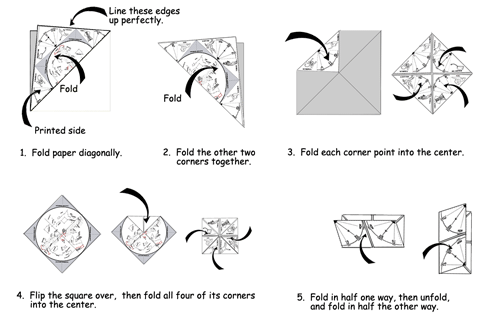
Play the Star Finder game:
-
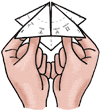 Stick your thumbs and first two fingers into the four pockets on the bottom of the Star Finder.
Stick your thumbs and first two fingers into the four pockets on the bottom of the Star Finder.
-
Ask another person to choose one of the top four
squares. Then, depending on the number on the square she chose, open
and close the Star Finder that many times (open up and down, close, open
side to side, close, etc.). For example, if she chose number 6, open
and close the Star Finder 6 times.

-
Then, ask the person to look inside the Star
Finder and pick one of the four visible constellations. This time, open
and close the Star Finder once for each letter to spell out his choice.
For example, if he chose "Lyra," you would open and close the Star
Finder 4 times, once for each letter: L - Y - R - A.
-
Ask the player again to pick one of the four
constellations visible. Open the panel to see the name of a
constellation (highlighted in red) she will try to find in the sky for
this month.
For some of the months, not every part of the Star Finder may show a highlighted constellation for you to find. In this case, just try to find the constellation that is nearest to the part of the sky you picked. Or, just find any constellation!
What ARE Constellations Anyway?
A constellation is group of stars like a dot-to-dot puzzle. If you join the dots—stars, that is—and use lots of imagination, the picture would look like an object, animal, or person. For example, Orion is a group of stars that the Greeks thought looked like a giant hunter with a sword attached to his belt.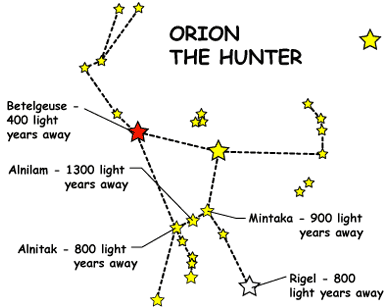
Other than making a pattern in Earth's sky, these stars may not be related at all. For example, Alnitak, the star at the left side of Orion's belt, is 817 light years away. (A light year is the distance light travels in one Earth year, almost 6 trillion miles!) Alnilam, the star in the middle of the belt, is 1340 light years away. And Mintaka at the right side of the belt is 916 light years away. Yet they all appear from Earth to have the same brightness.
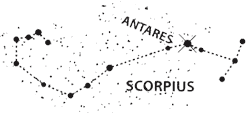 Even
the closest star is almost unimaginably far away. Because they are so
far away, the shapes and positions of the constellations in Earth's sky
change very, very slowly. During one human lifetime, they change hardly
at all. So, since humans first noticed the night sky they have
navigated by the stars. Sailors have steered their ships by the stars.
Even the Apollo astronauts going to the Moon had to know how to navigate
by the stars in case their navigation instruments failed.
Even
the closest star is almost unimaginably far away. Because they are so
far away, the shapes and positions of the constellations in Earth's sky
change very, very slowly. During one human lifetime, they change hardly
at all. So, since humans first noticed the night sky they have
navigated by the stars. Sailors have steered their ships by the stars.
Even the Apollo astronauts going to the Moon had to know how to navigate
by the stars in case their navigation instruments failed.
Finding the Constellations
We see different views of the Universe from where we live as Earth makes its yearly trip around the solar system. That is why we have a different Star Finder for each month, as different constellations come into view. Also, as Earth rotates on its axis toward the east throughout the hours of the night, the whole sky seems to shift toward the west.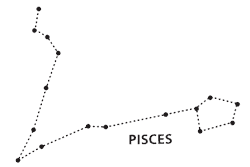 The
Star Finder charts are for a latitude of 34° N, which is about as far
north of the equator as Los Angeles, California. (Charts are from The Griffith Observer
magazine.) The farther north you are, the more the constellations will
be shifted south from the Star Finder charts. The Star Finder charts
show the sky at about 10 PM for the first of the month, 9 PM for the
middle of the month, and 8 PM for the last of the month. These are
local standard times. For months with Daylight Savings Time, star chart
times are an hour later.
The
Star Finder charts are for a latitude of 34° N, which is about as far
north of the equator as Los Angeles, California. (Charts are from The Griffith Observer
magazine.) The farther north you are, the more the constellations will
be shifted south from the Star Finder charts. The Star Finder charts
show the sky at about 10 PM for the first of the month, 9 PM for the
middle of the month, and 8 PM for the last of the month. These are
local standard times. For months with Daylight Savings Time, star chart
times are an hour later.
The star charts are maps of the sky overhead. So, to get the directions lined up, hold the map over your head and look up at it, and turn it so the northern horizon side is facing north.
If you live where big city lights drown out the beauty of the stars, you may see only a few of the brightest stars and planets. How sad! But see if you can find at least one or two constellations on a clear, Moonless night.

Some curious symbols ring the outside of the Star Finder. These symbols stand for some of the constellations in the zodiac. What is the zodiac and what is special about these constellations?
Imagine a straight line drawn from Earth through the Sun and out into space way beyond our solar system where the stars are. Then, picture Earth following its orbit around the Sun. This imaginary line would rotate, pointing to different stars throughout one complete trip around the Sun—or, one year. All the stars that lie close to the imaginary flat disk swept out by this imaginary line are said to be in the zodiac.
 The
constellations in the zodiac are simply the constellations that this
imaginary straight line points to in its year-long journey.
The
constellations in the zodiac are simply the constellations that this
imaginary straight line points to in its year-long journey.
In ancient times, astronomers did not fully understand how Earth, the Sun, and the stars moved. Nor did they have any idea the Universe is so vast. But they were keen observers of the sky and tried very hard to make sense of it.
People had already imagined that the constellations might be important symbols, telling stories of their gods and other myths. It was not a big step to suppose that the changing positions of the constellations at different times of the year might be important to people and events on Earth.
The Babylonians lived over 3,000 years ago. They divided the zodiac into 12 equal parts--like cutting a pizza into 12 equal slices. They picked 12 constellations in the zodiac, one for each of the 12 "slices." So, as Earth orbits the Sun, the Sun would appear to pass through each of the 12 parts of the zodiac. Since the Babylonians already had a 12-month calendar (based on the phases of the Moon), each month got a slice of the zodiac all to itself.
 But
even according to the Babylonians' own ancient stories, there were 13
constellations in the zodiac. (Other cultures and traditions have
recognized as many as 24 constellations in the zodiac.) So the
Babylonians picked one, Ophiuchus, to leave out. Even then, some of the
chosen 12 didn't fit neatly into their assigned slice of the pie and
slopped over into the next one.
But
even according to the Babylonians' own ancient stories, there were 13
constellations in the zodiac. (Other cultures and traditions have
recognized as many as 24 constellations in the zodiac.) So the
Babylonians picked one, Ophiuchus, to leave out. Even then, some of the
chosen 12 didn't fit neatly into their assigned slice of the pie and
slopped over into the next one.
 When the Babylonians first invented the 12 signs of
zodiac, a birthday between about July 23 and August 22 meant being born
under the constellation Leo. Now, 3,000 years later, the sky has
shifted because Earth's axis (North Pole) doesn't point in quite the
same direction.
When the Babylonians first invented the 12 signs of
zodiac, a birthday between about July 23 and August 22 meant being born
under the constellation Leo. Now, 3,000 years later, the sky has
shifted because Earth's axis (North Pole) doesn't point in quite the
same direction.
Now Mimi's August 4 birthday would mean she was born "under the sign" of Cancer (one constellation "earlier"), not Leo.
The constellations are different sizes and shapes, so the Sun spends different lengths of time lined up with each one. The line from Earth through the Sun points to Virgo for 45 days, but it points to Scorpius for only 7 days. To make a tidy match with their 12-month calendar, the Babylonians ignored the fact that the Sun actually moves through 13 constellations, not 12. Then they assigned each of those 12 constellations equal amounts of time. Besides the 12 familiar constellations of the zodiac, the Sun is also aligned with Ophiuchus for about 18 days each year.
If you want to find out what your "sign" really is (not that it matters!), here are all 13 traditional constellations in the zodiac and the dates the Sun "passes through" them.
THANK YOU NSA
http://spaceplace.nasa.gov/starfinder2/